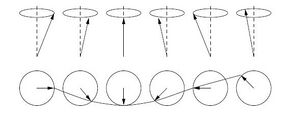A solved problem for spin waves: Difference between revisions
No edit summary |
No edit summary |
||
| (One intermediate revision by the same user not shown) | |||
| Line 1: | Line 1: | ||
''' | A chosen problem with solution by Hossein. | ||
'''Problem:''' | |||
(a) Making use of the spin commutation relation,<math>[s_{i}^{\alpha },s_{j}^{\beta }]=i\delta _{ij}\varepsilon ^{\alpha \beta \gamma }s_{i }^{\gamma }</math> , apply the identity | (a) Making use of the spin commutation relation,<math>[s_{i}^{\alpha },s_{j}^{\beta }]=i\delta _{ij}\varepsilon ^{\alpha \beta \gamma }s_{i }^{\gamma }</math> , apply the identity | ||
| Line 39: | Line 41: | ||
(c) The corresponding spin wave solution has the precessional from shown in blow figurer. | (c) The corresponding spin wave solution has the precessional from shown in blow figurer. | ||
[[Image:2.JPG|thumb|center|450.px| Spin-wave dispersion.]] | |||
Latest revision as of 13:57, 9 December 2010
A chosen problem with solution by Hossein.
Problem:
(a) Making use of the spin commutation relation, , apply the identity
To express the equation of motion of a spin in a nearest neighbor spin S one dimensional Heisenberg ferromagnet.
(b)Interpreting the spins as classical vectors, and taking the continuum limit, show that the equation of motion of the hydrodynamics modes takes the form
Where a denotes the lattice spacing.
(c) Confirm that the equation of motion is solved by the Ansatz,
and determine the dispersion, sketch a snapshot configuration of the spins in the chain.
Solution:
(a) Making the use of equation of motion and the commutation relation ,, we obtain
(b) Interpreting the spins as classical vectors, and applying the Taylor expansion
We obtain the classical equation of motion
Substituting, we find that , satisfies the equation of motion with .
(c) The corresponding spin wave solution has the precessional from shown in blow figurer.
![{\displaystyle [s_{i}^{\alpha },s_{j}^{\beta }]=i\delta _{ij}\varepsilon ^{\alpha \beta \gamma }s_{i}^{\gamma }}](https://wikimedia.org/api/rest_v1/media/math/render/svg/6f0e9681eeeed19b4ca1b2eb21ac8c0de8917e08)
![{\displaystyle i{\dot {s}}_{i}=[{\hat {s_{i}}},{\hat {H}}]}](https://wikimedia.org/api/rest_v1/media/math/render/svg/961038b375b8517d26f5f6d2754fba96172d5f40)





